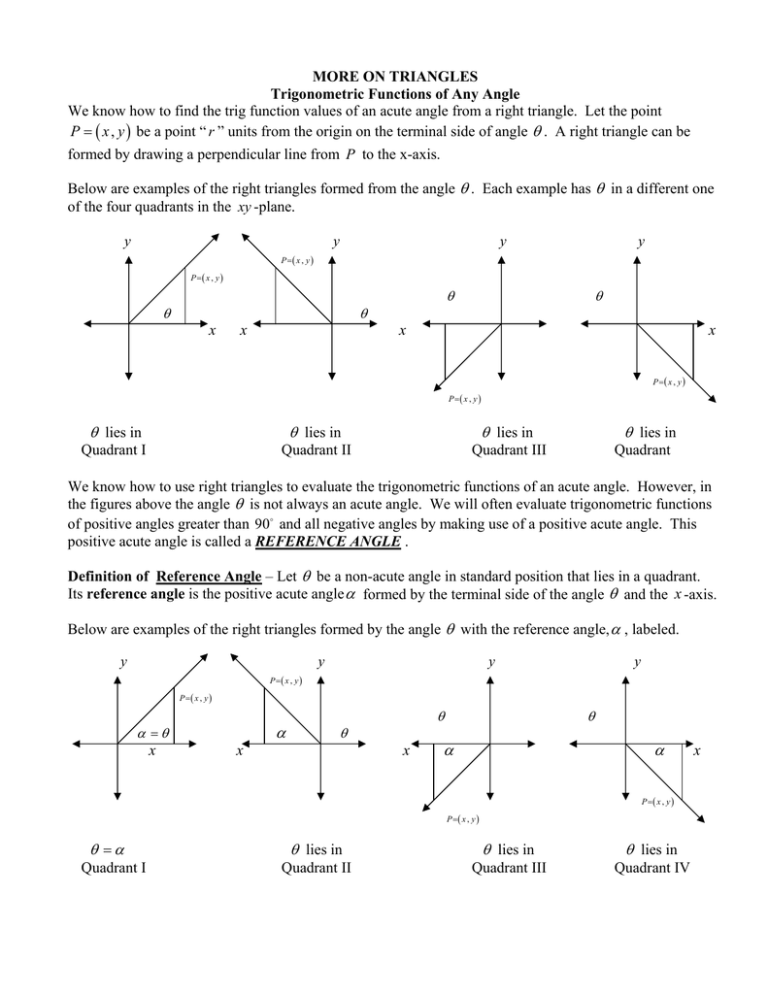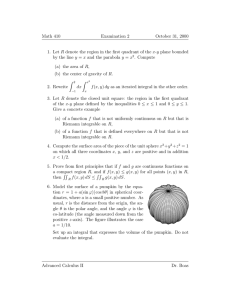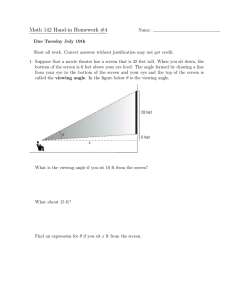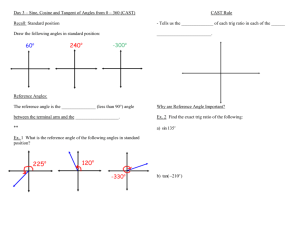( ) θ
advertisement

MORE ON TRIANGLES Trigonometric Functions of Any Angle We know how to find the trig function values of an acute angle from a right triangle. Let the point P = ( x , y ) be a point “ r ” units from the origin on the terminal side of angle θ . A right triangle can be formed by drawing a perpendicular line from P to the x-axis. Below are examples of the right triangles formed from the angle θ . Each example has θ in a different one of the four quadrants in the xy -plane. y y y y P =( x , y ) P =( x , y ) θ θ θ x x θ x x P =( x , y ) P =( x , y ) θ lies in Quadrant I θ lies in Quadrant II θ lies in Quadrant III θ lies in Quadrant We know how to use right triangles to evaluate the trigonometric functions of an acute angle. However, in the figures above the angle θ is not always an acute angle. We will often evaluate trigonometric functions of positive angles greater than 90o and all negative angles by making use of a positive acute angle. This positive acute angle is called a REFERENCE ANGLE . Definition of Reference Angle – Let θ be a non-acute angle in standard position that lies in a quadrant. Its reference angle is the positive acute angle α formed by the terminal side of the angle θ and the x -axis. Below are examples of the right triangles formed by the angle θ with the reference angle, α , labeled. y y y y P =( x , y ) P =( x , y ) α α =θ x θ θ x x θ α α P =( x , y ) P =( x , y ) θ =α Quadrant I θ lies in Quadrant II θ lies in Quadrant III θ lies in Quadrant IV x Examples: Find the reference angle α for each of the following angles θ . (i) θ = 60o then α = __________ (ii) θ = 135o then α = __________ (iii) θ = 210o then α = __________ (iv) θ = −45o then α = __________ Once again we have our examples of the right triangles formed by the angle θ with the reference angle, α , labeled. P =( x , y ) P =( x , y ) θ r α =θ x y θ r y α θ α x x x α r y r y P =( x , y ) P =( x , y ) Quadrant I Quadrant II Quadrant III Quadrant IV Notice that for each right triangle, the length of the side opposite α is y (the y -coordinate of the point P ). The length of the side adjacent to α is x (the x -coordinate of the point P ). Using Pythagorean’s Theorem, we can find the length of the hypotenuse, r . So the trigonometric functions evaluated at α are defined as: sin α = opposite hypotenuse csc α = = hypotenuse opposite y r = cos α = r y sec α = adjacent x = hypotenuse r hypotenuse adjacent = r x tan α = opposite y = adjacent x cot α = adjacent opposite = x y Using Reference angles to evaluate trigonometric Functions The values of the trigonometric functions of a given angle, θ , are the same as the values of the trigonometric functions of the reference angle, α , except for possibly the sign. A function value of the acute reference angle α is always positive. However, the same function value for θ may be positive or negative. Example: Let the point P = ( x , y ) = ( 3, − 4 ) be on the terminal side of the angle θ . Find sin θ and cosθ . θ α Using Pythagorean’s Theorem and the facts that we know from right triangles: x=3 90o 2 2 2 x +y =r α 32 + 42 = r 2 9 + 16 = r 25 = r P = (3 , − 4) y=4 r =5 2 2 5=r Recall that when using the reference angle α the x , y , and r values are all positive. So, sin α = y 4 = r 5 cos α = and x 3 = . r 5 "− y " − 4 . = r 5 "+ x " 3 However, also since θ lies in quadrant IV, the x -coordinate is positive. So, cos θ = cos α = = . r 5 Since θ lies in quadrant IV, the y -coordinate is negative. So, sin θ = − sin α = Example 2: Find the sin θ and cosθ for θ = 150o . When the reference angle, α , is a common angle (30o , 45o , 60o ) we do not need to use Pythagorean’s Theorem to help us establish a right triangle. Instead the right triangle defined by the reference angle will be one of our basic triangles. θ If θ = 150o then the reference will be α = 30o . So the right triangle is a 30 − 60 − 90 triangle: o o α o 60o y= 1 r =1 2 α = 30o 90o 3 x= 2 Recall that when using the reference angle α the x , y , and r values are all positive. So, sin α = y 1/ 2 1 = = r 1 2 and Since θ lies in quadrant II, the y -coordinate is positive. So, sin θ = sin α = "+ y " 1/ 2 1 = = . r 1 2 cos α = x = r However, also since θ lies in quadrant II, the x -coordinate is negative. So, cos θ = − cos α = "− x " − 3 / 2 3 . = =− r 1 2 3/2 3 . = 1 2 Reference for information: Algebra & Trigonometry 2nd Ed. by Robert Blitzer






